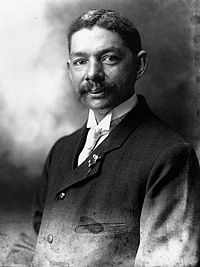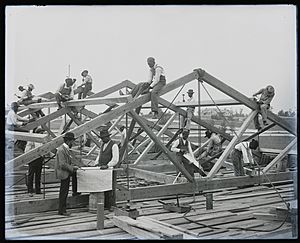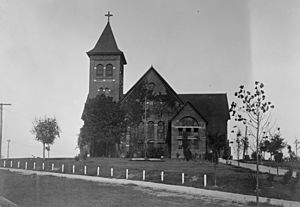Robert Robinson Taylor facts for kids
Quick facts for kids
Robert Robinson Taylor
|
|
|---|---|
 |
|
| Born | June 8, 1868 |
| Died | December 13, 1942 (aged 74) |
| Education | Massachusetts Institute of Technology |
| Occupation | Architect |
| Spouse(s) | Beatrice Rochon Taylor Nellie Chestnut Taylor |
| Children | 5 |
| Parent(s) | Henry Taylor Emily Still |
| Relatives | Robert Rochon Taylor (son) Barbara T. Bowman (granddaughter) Valerie Jarrett (great-granddaughter) |
Robert Robinson Taylor (born June 8, 1868 – died December 13, 1942) was an important American architect and teacher. He was the very first African-American student to attend the Massachusetts Institute of Technology (MIT). When he graduated in 1892, he became the first African-American to be a certified architect.
Taylor was a key person at the Tuskegee Institute. He helped design many of its first buildings. He also helped create the school's hands-on learning programs. He worked closely with Booker T. Washington, who founded Tuskegee. Taylor spent over 40 years working as an architect in the southern United States.
Contents
Early Life and Education
Robert Robinson Taylor was born on June 8, 1868, in Wilmington, North Carolina. His father, Henry Taylor, was a carpenter and businessman. Henry was born into slavery but became free in 1847. Robert's mother, Emily Still, was the daughter of people who were already free before the Civil War.
In 1888, Robert left home to study architecture at MIT. He was a very good student. He even received a special scholarship for two years. While at MIT, he met Booker T. Washington. Washington wanted Taylor to help build new structures at Tuskegee. He also wanted Taylor to create a program for students to learn practical skills.
In May 1892, Taylor was one of 12 students to earn an architecture degree from MIT. After graduating, he decided to join Tuskegee later that year.
Building a Career
Taylor's first project at Tuskegee University was the Science Hall, finished in 1893. Students built this hall themselves, even making the bricks under Taylor's guidance. This project showed Booker T. Washington's belief that physical work was important. It also proved what African Americans could achieve in building.
Many other buildings followed at Tuskegee. These included the original Tuskegee Chapel, built from 1895 to 1898. He also designed The Oaks, which became the president's home in 1899.
From 1899 to 1902, Taylor worked in Cleveland, Ohio. He worked for himself and for an architecture firm there. When he returned to Tuskegee in 1902, he became the architect and director of "mechanical industries." He held this role until he retired in the mid-1930s. Taylor and Washington used MIT as a model for Tuskegee's programs. Taylor even gave a speech at MIT in 1911, explaining how Tuskegee used MIT's ideas.
Taylor also designed buildings for other places. He created Carnegie libraries at Wiley College in Marshall, Texas, and at Livingstone College in Salisbury, North Carolina. He worked with another black architect, Louis H. Persley. Together, they designed large buildings at Selma University in Selma, Alabama. They also designed the Colored Masonic Temple in Birmingham, Alabama, which was an office and entertainment spot.
In 1925, Taylor became the vice-principal of Tuskegee. In 1929, he traveled to Kakata, Liberia. He helped plan the Booker Washington Institute, which was meant to be like Tuskegee in Africa. Robert Taylor also served on a commission to help with flood relief. He was also the head of the Tuskegee chapter of the American Red Cross.
After retiring in 1935, Taylor moved back to his hometown of Wilmington, North Carolina. The governor of North Carolina appointed him to the board of trustees for what is now Fayetteville State University.
Family Life
In 1898, Robert married Beatrice Rochon Taylor. They had four children. One of their sons, Robert Rochon Taylor, became a well-known supporter of better housing in Chicago. Beatrice's younger sister was a teacher and pharmacist named Etnah Rochon Boutte. After Beatrice passed away in 1906, Robert married Nellie Chestnutt in 1912. They had one child together.
Later Years and Passing
Robert Robinson Taylor died on December 13, 1942. He passed away while attending a service in the Tuskegee Chapel. This chapel was the building he felt was his greatest architectural achievement. He was buried in the Pine Forest Cemetery in Wilmington, North Carolina.
Lasting Impact
The Taylor School of Architecture and Construction Science at Tuskegee University is named after Robert Robinson Taylor. The Robert Taylor Homes housing project in Chicago was named after his son, Robert Rochon Taylor.
The United States Postal Service honored him with a postage stamp. His great-granddaughter, Valerie Jarrett, was a senior advisor to Former President Barack Obama.
Key Projects
Here are some of the buildings Robert Robinson Taylor designed:
- Huntington Hall (1900)
- Emery dormitories (four buildings, 1900)
- Dorothy Hall (1901) at Tuskegee Institute
- Women's Trades Building (1901)
- Carnegie Library (1901)
- Administration Building (1902–03)
- Rockefeller Hall (1903)
- Men's Residence Hall (1904)
- Douglass Hall (1904)
- Collis P. Huntington Memorial Building (academic building, 1904–05)
- Tantum Hall (1907)
- Milbank Agriculture Building (1909)
- Tompkins Hall (dining facility, 1910)
- White Hall (women's dormitory, 1910)
- John A. Andrew Memorial Hospital (1913)
- Laundry, now The George Washington Carver Museum (1915)
- James Hall (1921)
- Prince Hall Masonic Temple (1924)
- Sage Hall (1927)
- Wilcox Trade Buildings (architecture buildings, 1928)
- Logan Hall (old gym, 1931)
- Armstrong Science Building (1932)
- Hollis Burke Frissell Library (1932)



